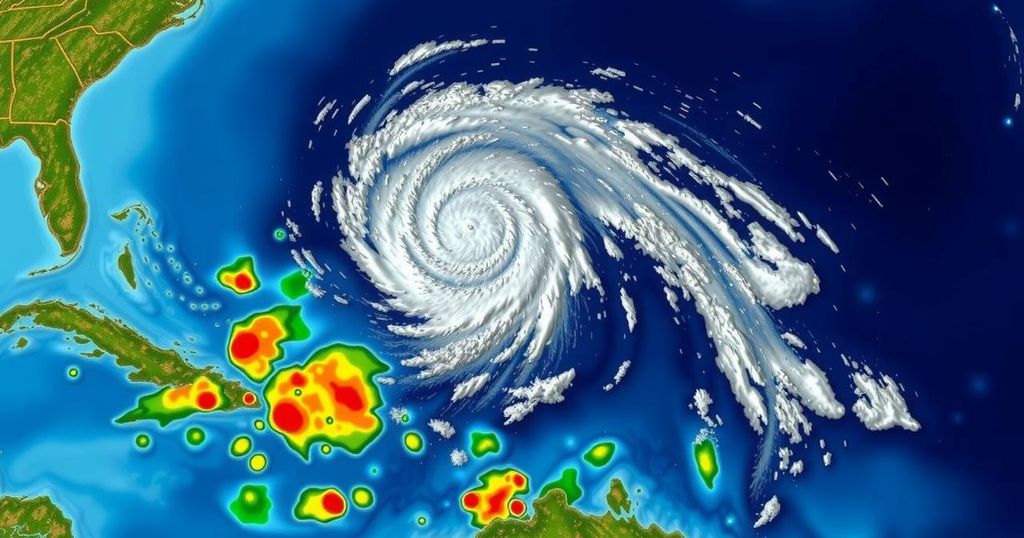Rapid Transition: How Hurricane Oscar Surprised Forecasting Models
Hurricane Oscar rapidly intensified from a tropical wave to a Category 1 hurricane over the course of a weekend, surprising many forecasting models that initially predicted low chances of development. Human observations and quick reconnaissance data collection proved crucial in alerting areas at risk, enabling timely preparations before the storm made landfall in the Bahamas and Cuba.
On Friday evening, a disorganized tropical wave to the east of Puerto Rico had a mere 10% chance of developing into a stronger system over the weekend. However, by Saturday afternoon, this system escalated into Hurricane Oscar, a Category 1 hurricane that threatened the Bahamas. Meteorologists noted that this tiny storm had been overlooked by most major forecasting models. Yet, vigilance from meteorologists and reconnaissance missions undertaken by pilots enabled timely alerts to be issued just prior to Hurricane Oscar’s impact. Philippe Papin, the forecaster for the National Hurricane Center on Saturday morning, noted initial signs of a developing circulation while analyzing satellite imagery focused on passive microwave data. “It became pretty clear that a small circulation was developing,” he remarked to the Miami Herald, underlining the rapid adjustments that needed to be made in their forecasts. By 11 a.m., the hurricane center had released its first forecast for Tropical Storm Oscar, directing attention towards the Bahamas and Cuba, leading to the issuance of tropical storm warnings. A coordinated response from the Hurricane Hunters swiftly deployed to gather more data revealed that what had previously been observed was not indicative of the storm’s true nature; in fact, the reconnaissance flight detected significant changes just before the system transformed from Tropical Storm Oscar to Hurricane Oscar within hours. Hurricane Oscar made landfall on Great Inagua Island in the Bahamas the following morning before striking the eastern coast of Cuba later that evening. The models initially predicted the storm’s potential as it formed off the coast of Africa a week prior, but a surge of dry air was believed to have diminished its intensity. Though there were early indications of the storm’s development, the reconstructions ultimately provided the crucial data needed to accurately update the models. Phil Klotzbach, a senior research scientist at Colorado State University, noted that the models struggled to resolve the developing circulation due to its small size. “I think the models just had a hard time resolving the circulation before they got the recon in there,” he stated. Despite the variability of storm predictions, Papin acknowledged that, “size is definitely an important part of the equation of why the models weren’t handling this storm so well.” Ultimately, Hurricane Oscar was a small storm, but its quick escalation highlighted the challenges posed by accurately forecasting such systems, particularly when they possess limited wind radii, making them difficult to predict before significant pressure builds. In conclusion, Hurricane Oscar’s rapid development from a tropical wave into a significant hurricane underscores the intricacies of storm prediction, particularly for small storms that can often evade typical forecasting models. The timely human intervention and data collection played crucial roles in issuing early warnings, emphasizing the need for ongoing advancements in meteorological forecasting models to ensure preparedness in the face of rapidly evolving weather phenomena.
The ability to predict hurricanes relies heavily on computer modeling, which analyzes a range of atmospheric data to forecast storm behavior. However, these models can struggle with small storms, particularly when they exhibit rapid intensification. Observations from reconnaissance flights, which collect real-time data from within these systems, are vital in enhancing model accuracy and improving timely alerts to affected areas.
This incident illustrates the vital role human intervention plays in weather forecasting, especially for rapidly developing systems like Hurricane Oscar. Despite the models’ shortcomings in accurately tracking the storm’s evolution, quick action from meteorologists and reconnaissance teams helped mitigate potential disaster by ensuring warnings were issued with limited lead time. Continuous improvement in modeling techniques and timely data collection are imperative for future hurricane preparedness.
Original Source: www.tampabay.com




Post Comment